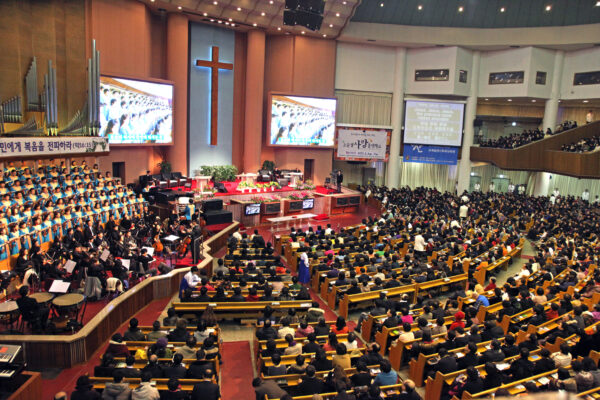South Korean megachurches are growing and innovating, despite a competitive Korean religious market, reported The Diplomat, in a story about CRCC-sponsored research. Despite many church-related controversies like sex scandals and embezzlement, church members stay generally satisfied with their congregation.
The Diplomat interviewed Sung Gun Kim, the leader of the Seoul research team for CRCC’s Religious Competition and Creative Innovation Project, who has researched how these churches have evolved to fit with contemporary times.
To expand their reach, South Korean churches create recognizable brands and promote through social networks and online websites. This has helped enhance the image of Korean megachurches, which are linked with happiness and affluence. Spiritual leaders are so central to this image that church members are willing to forgive their leaders’ mistakes. Kim said that this love of religious leadership is linked to South Korea’s history with authoritarian Confucianism and spiritual shamanism, and these past and present factors are enabling Korean churches to thrive within its competitive market.
An excerpt from the article:
Detracting public scorn away from their dynastic leadership and storehouses of wealth, churches make themselves impervious to criticisms of their affluence. “Megachurches that are impervious to secular accusations had created innovative ways that showed their pure intention of deepening their relationship with God,” Kim writes in a study on megachurches. They pray for the health of others. In attempting to play down their churches’ corporate image, senior leaders vow to not own church property and to limit elders’ tenures. With a history of supporting the status quo and accommodating to authoritarian regimes in the 1970s and 1980s, they veer away from political and popular themes such as love and money to focus on biblical teachings — considered a novel approach in Korea that is leading to higher levels of regular tithes, Kim says.
So what does this mean for the future of religion in Korea? Studies suggest that young people who were raised Buddhist are converting to Catholicism, which is growing in popularity thanks to Pope Francis’ 2015 visit and the church’s image of transparency in Korea. Catholic and Protestant approaches are both becoming more progressive in their evangelization, with their styles converging so there is little difference between the two.
While experts predict that megachurches in the United States will face a decline in the near future, Kim expects that Korean megachurches’ stronghold will grow. With more and more people concentrating in the very largest congregations, Kim believes the “religious concentration” phenomenon is spreading to other religions like a Buddhist mega-temple. “These churches are doing things differently to keep themselves not only ‘healthy’ as a congregation but also to ‘innovate’ themselves to defy the accusations in the present Korean religious market,” he tells The Diplomat.





